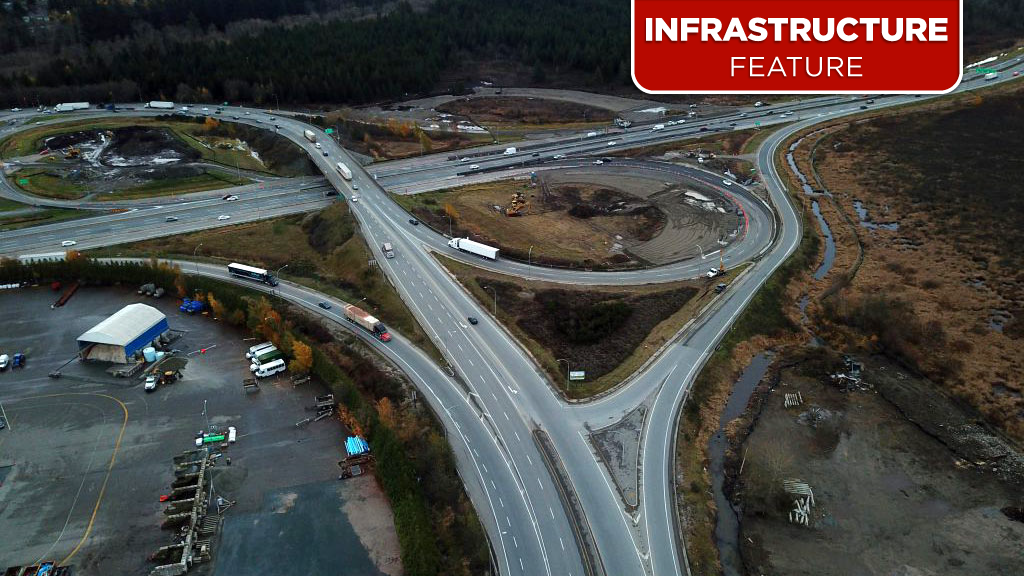A $260-million upgrade project along Highway 91C near Highway 17 in Delta, B.C., is far from your typical road rebuild.
The thoroughfare is between two very sensitive environmental features — the Fraser River and Burns Bog — and, as a result, ground conditions are far from ideal which has resulted in the builder using a variety of techniques in order to upgrade an existing interchange and enable construction of three new ones.
“The construction techniques being used reflect these conditions, which are typical of construction within the Fraser River Delta area, and here surface soil is primarily silt, sand and peat,” explains Jody Deane, executive project director for the upgrade with the B.C. Ministry of Transportation and Infrastructure.
“Another challenge is construction within an active highway and industrial area. Because of the complexity of the transportation system in and around the project site, effective traffic management is key to our success — minimizing disruption and keeping traffic moving.”
The project is designed to improve the operation of existing roads and make the routes safer and more efficient for local residents and commercial drivers. It includes upgrades to the existing interchange at Highway 91 and Nordel Way and construction of three new interchanges — at Highway 91C and Nordel Way, Highway 91C and Highway 17, and Highway 17 and River Road.
Work on the project began in spring 2020 and substantial completion is scheduled for fall 2022, with total completion in spring 2023. Pacific Gateway Constructors General Partnership, a consortium comprised of Ledcor, Aecon and BEL Contracting, was awarded the design-build contract for the work in 2019.
The contractor is using three specific techniques to consolidate, stabilize and strengthen the soil to ensure the ground will be able to bear the weight of the heavy interchanges. The techniques being used are preloading and surcharging, installing stone columns, and putting in pile foundations.
Preloading and surcharging involve placing fill material, like sand, on the surface of the ground prior to construction to consolidate and compress the underlying soil. Up to 600,000 cubic metres, or 240 Olympic-size swimming pools, worth of sand will be used for pre-load and embankment work.
With stone column installation, a vibrating probe is used to push layers or columns of gravel into the ground. The vibrating action compacts the soil and creates a good foundation. Approximately 2,000 stone columns of varying depths will be installed in the project area, primarily in areas where roadway connections to new highway bridges are being built.
Piled foundations will be used when the soil can’t bear the weight of the structure that is being built without the possibility of the soil expanding, contracting or shifting. Thirty-two reinforced concrete piles will be used in the construction of the project’s bridges and overpasses, and 30 steel piles will be needed for highway overhead directional signage.
“Typically, a construction contractor will select which technique to use based on a number of factors, including ground conditions, loads, area accessibility, and the equipment available,” says Deane.
Fill placement, embankment construction and stone column installation are presently under way at the project and foundation work, shaft drilling for the construction of bridges and overpasses has also started.
The area is a beehive of activity with excavators, earthmovers and compactors, cranes, sweepers and hydrovac trucks on scene.
Deane says due to the complexity of the transportation system in and around the project site, effective traffic management is key to minimizing disruption and keeping vehicles moving.
“Co-ordination is key – both from a construction staging and traffic management perspective,” she says.
To keep traffic flowing, most alignments like new roads, ramps, and bridges are built outside the existing highway roadway. Once they are built, traffic is detoured onto the new alignments, allowing the builder to modify the existing highway roadway for the new design. Once the existing highway roadway is modified, the new configuration is opened to traffic. Then, the temporary roads and ramps are removed.
Because all the roads are important and busy transportation routes, Deane says proactive planning and co-ordination with key stakeholders and other projects in the area is important to minimize disruption
Another important consideration in upgrading the highway is maintaining the integrity of nearby Burns Bog.
Deane says Pacific Gateway is following construction management plans based on best practices to avoid or minimize potential environmental impacts to Burns Bog, including air quality and dust control, soil erosion and sediment control, as well as protecting vegetation, wildlife and aquatic resources.
The design-builder has also obtained all necessary environmental permits for work in the area, which include obligations to protect and maintain adjacent environmental features, she says.
For example, drainage ditches on the project have been designed to drain stormwater away from the bog. Engineered berms will also be constructed and planted adjacent to the bog to reduce the intrusion of non-bog water.
The province is also conducting environmental monitoring during construction to ensure compliance with all requirements and commitments. Post-construction monitoring will be undertaken to confirm the effectiveness of long-term environmental protection measures.











Recent Comments
comments for this post are closed